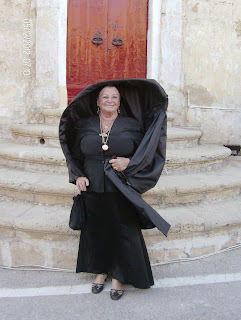Lace making can be hand made or manufactured. There are different types of lace the bobbin or pillow lace, needlelace, knitted, tatting, tape lace, decorated nets, crochet, macramé, filet and netting, tenerife and Nanduti. The thread used is silk, linen or cotton.
Hand made LaceThere are early types of names Rose point, Venetian point and Maltese point. This is the method Lace making as is still known today. Rose point shows a rich embossment. Venetian and Maltese they are both formed in flat figures, the Maltese lace is remarkable because it is made using masses of combined threads.
Maltese Lace or Bizilla
Lace making in Malta and Gozo dates back in the 16th century. It is based on the pattern of the Venetian point.
In the 19th century the Italian Genoese bobbin lace was introduced to the Maltese and soon they created their own patterns.
 |
| Leaver Machine |
This is the Leavers lace machine. It was invented in 1800s. It produced pattern and background simultaneously. Lace produce by machine it was high quality, faster to make and cheaper to buy.
During The Great Exhibition in London Queen Victoria was given Maltese lace and she loved it and so it became popular. Maltese designs were copied and sent to China and India to be manufactured.
The lace pillow with thread and bobbins
.jpg) |
| Different types of lace |
.jpg)
Lace with Maltese cross
 |
| Maltese women - Lace maker |
 |
| Gozitan- Lace maker |
 |
| Gozo Lace and a picture Dun Guzepp Diacono who promoted in Gozo |
African Lace
Before 1880 lace in Nigeria was made by hand but then they started using machinery. It is a symbol of Nigeria. Lace is handed from generation to generation. There was a cultural interaction among Nigeria, Switzerland and Austria. Nigerian lace was in fashion during the 1960's.
African lace is produced in Europe for the west African market. It is the modern version machine produce embroidery. It is worn on special occasions such as weddings, baptisms and birthdays.
 |
| Old-fashioned embroidery machine |
African Embroidered Lace
The Lace in Malta was made by hand. It was either white or ivory. The thread was fine quality and expensive. The African lace is mainly manufactured and very colourful.
Harvard System
Website
101 Things to do in Malta. n.d. Watch Maltese Lace-making. [ONLINE] Available at:http://www.101malta.com/en/home/articles/245/watch-maltese-lace-making.htm. [Accessed 16 May 15]
airmalta. n.d. Lace making. [ONLINE] Available at: http://www.airmalta.com/destinations/malta/best-of-malta/culture/lace-making. [Accessed 23 May 15].
Maltese History & Heritage. n.d. Maltese Crafts. [ONLINE] Available at:https://vassallohistory.wordpress.com/maltese-crafts/. [Accessed 16 May 15].
The Lace Guide. 1979. The Origins of Lace. [ONLINE] Available at: http://www.laceguild.org/craft/history.html. [Accessed 13 May 15].
Africa Fashion Guide. 2015. Textiles blog (blog). [ONLINE] Available at:http://www.africafashionguide.com/2012/05/from-silke-to-african-lace-to-lagos-business-angels-specialist-interview-textile-review-2/. [Accessed 16 May 15].
Book
De Piro ,N & Ann Cremona, V (1998). Costume in Malta - A History of Fabric, Form & Fashion. 2nd ed. Malta: Patrimonju Publishing Ltd.




.jpg)









.jpg)

.jpg)






.jpg)



.jpg)
.jpg)



.jpg)
.jpg)





















